Chief Officer Wilde - Sea Career
-1893 - 1902
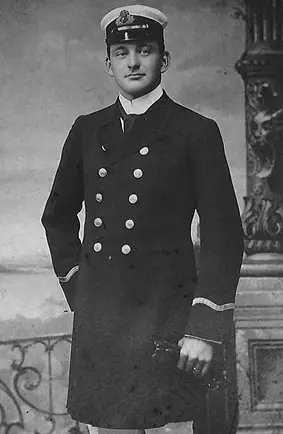
An early photograph of Henry T Wilde,
circa 1900, courtesy of Chris Bayliss/Champ News
(Click image to enlarge)
Henry Wilde served his 4 year apprenticeship aboard the Greystoke Castle from the 23rd of October 1889 until the 22nd of October 1893, but then remained onboard, signing on the very next day - the 23rd of October 1893 for a further one month and 13 days in the role of Third Mate. He signed off on the 5th of December 1893 and ten days later presented himself at the Liverpool Board of Trade offices and paid the fee for the examination for his second mate's certificate on the 15 December 1893. On the 8th of January 1894 he passed all subjects and received his qualification. At the time his address is listed as 155 Rice Lane, Walton.
With his Second Mate certification sorted Wilde began his career at sea by taking a job a month later, on the 15th of February 1894, as Third Mate on the square rigged 1374-ton Hornby Castle sailing ship, which was also owned by the Lancashire Shipping Co. - James Chambers & Co.- Castle Line, Liverpool. A cargo ship with three masts and made of iron, it was likely an older version of the Greystoke Castle in many respects.
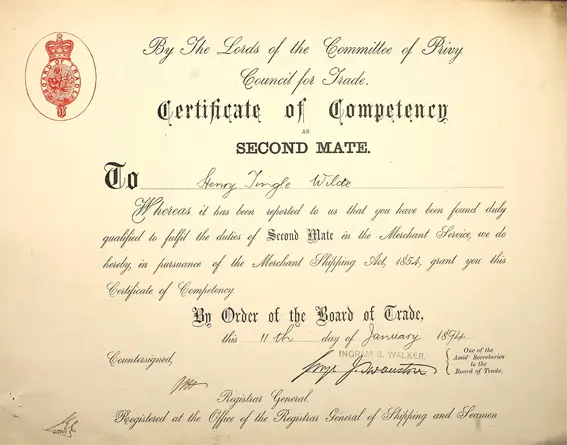
Henry Wilde's Second mate certificate.
(Click image to enlarge)
Wilde spent 10 months and 21 days on the Hornby Castle. But he was very soon to make the transition to steam.
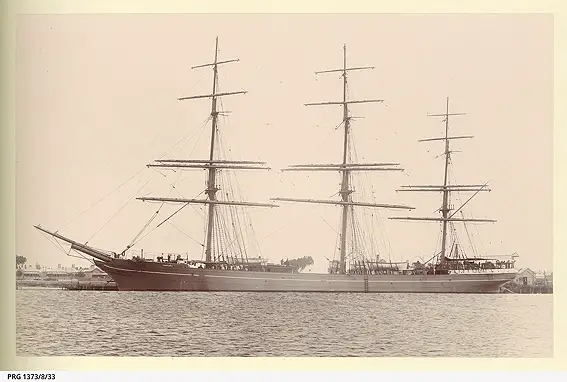
Wilde worked as Third Mate aboard the Hornby Castle, a square rigged 1374-ton sailing ship. (Click image to enlarge)
Steam Ships and Certificates
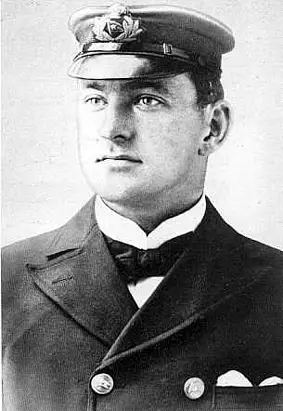
The most famous portrait of
Chief Officer Wilde. (Click to enlarge)
The 977 ton SS Brunswick was built in 1883 a steel screw steamer with the original name of the SS Moruca when it was owned by Caw & Co based in Glasgow. However, in 1895 the Liverpool & Maranham S.S. Co. Ltd. (H. Evans & Co., Liverpool) took ownership of the passenger and cargo ship and renamed her the SS Brunswick. Wilde was brought onboard on the 23rd of March 1895 in his role as third mate. The ship was 275.0 ft long, with a breadth of 33.2ft and a depth of 19.9ft with a single screw C2cyl (32, 63 x 45in), 200nhp engine. (http://www.clydeships.co.uk/)
Clearly Wilde took to steam as after only 2 months and 25 days as third mate he was promoted to second mate on the 17th of June 1895, serving in this capacity aboard the SS Brunswick for 24 days.
Having made the transition to steam he now looked ahead at further promotion and applied and passed his First Mate certification on the 29th of July 1895, once again passing on his first attempt.. He noted on his application that he kept the 8 to 12 morning and evening watches, and had ‘sole charge’ of the SS Brunswick. Not long after, on the 10th of August he returned to the SS Brunswick for another two voyages, both lasting more than three months each, until April 1896.
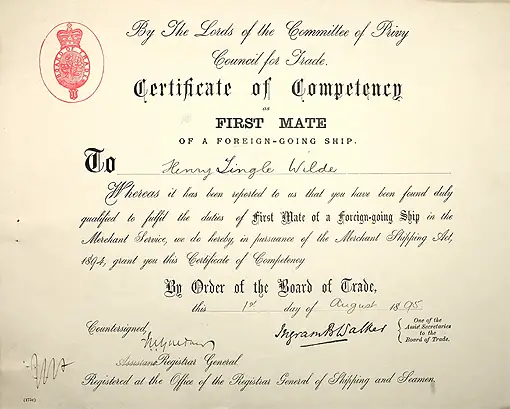
Henry Wilde's First mate certificate.
On the 30th of June, Wilde signed on to a different ship - the SS Europa and served aboard her as the Second Mate for three voyages, each lasting about three months each (30/6/96 - 24/9/96, 29/9/96 - 12/1/97, 15/1/97 - 23/4/97). The Europa was mostly likely an Elder Dempster line vessel on the Africa route and if so it was built in 1881 ad was 2,232 tons and in 1894 had been taken over by The City of Liverpool S.N. Co.(shiplist.com)
Perhaps he felt he was stagnating in his role as second officer, having served in that capacity for more than two years. With his sights on greater things he signed off the SS Europa on the 23rd of April 1897 and then a month later sat for his master's certification on the 17th of May 1897.
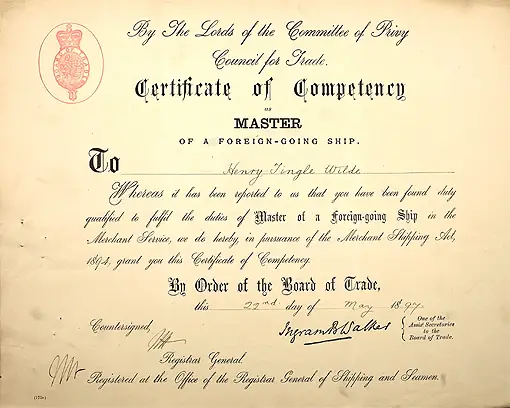
Henry Wilde's First mate certificate.
After three voyages he signed off her on the 23 April 1897 and sat for his master’s certification on the 17th of May 1897.
While he attended a Liverpool ‘crammer’ – a navigation school geared towards preparing would-be officers for their examinations – Wilde met a young officer named Stanley Lord who was studying for his first mate’s certification. (When Lord was studying for his master’s certificate in 1901 he stayed at 56 Grey Road, a near neighbour of Wilde who was then living in the same street). It is indicative of his ability that Wilde once again passed at his first attempt at the examination - many other would-be officers were not so fortunate, and the failure rate was high. He was less successful when, on the 15 July 1897, he first sat for his extra master’s certification. Navigation proved to be his undoing, and the certificate was withheld. ("On Watch" - Nautical-papers.com, 2002 by Jemma Hyder and Inger Sheil)
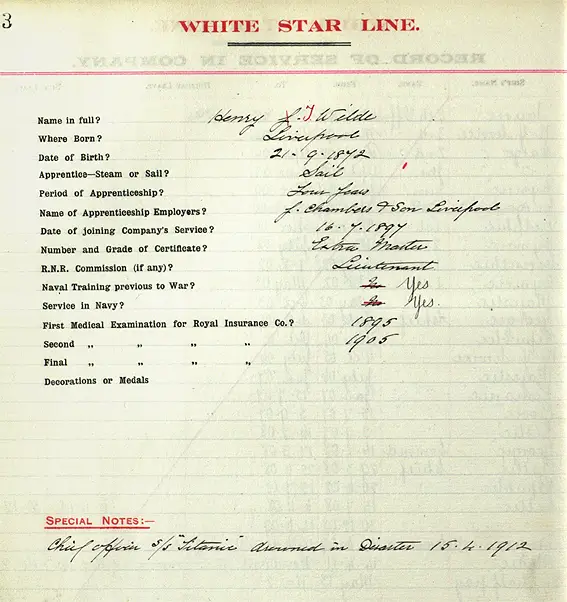
Henry Wilde's White Star Line record, which shows that he joined the line
on the 16th of July 1897. (Document courtesy of Petra Feyahn)
White Star Line
While Wilde had failed to achieve his Extra Master's certificate (15th July 1897) his master's certificate was enough for him to consider applying to the White Star Line, considered to be one of the world's most prestigious shipping lines in July 1897. According to his White Star Line record (above) Wilde joined the company on the 16th of July 1897.
The Line could afford to be selective in choosing candidates, and to be chosen to serve on one of their ships was, as maritime commentator Frank Bullen wrote in 1900, an honour. ‘The hierarchy of merchant shipping, the great floating palaces belonging to such firms as the P. & O., the Cunard, the White Star, and the British India, to mention only a few, and without any invidious idea of selection, fall easily into a class by themselves, association with which in almost any capacity confers a sort of brevet rank upon a seaman’. Wilde evidently satisfied the Line’s criteria, and in July 1897 he joined the Covic [sic] as her fourth officer. ("On Watch" - Nautical-papers.com, 2002 by Jemma Hyder and Inger Sheil)
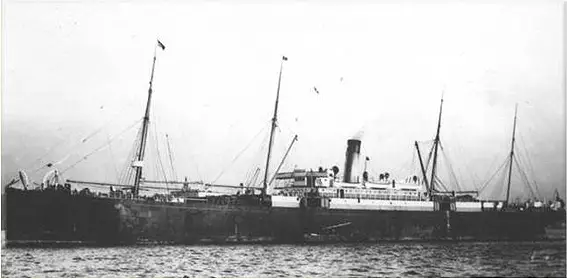
The SS Cevic was Wilde's first White Star Line ship he worked aboard, as fourth officer.
His first White Star ship was most likely the SS Cevic (note: his BOT papers read "Covic" but no such White Star ship exists, and the "O" can easily be interpreted an E), an 8,301 GRT steam ship built in 1893 initially for the North Atlantic but later transferred to the Australian run. She was one of the largest cargo ships in the world in her day and, in addition to her normal cargo holds, was equipped to carry up to 1000 head of cattle. Wilde served aboard her as the fourth officer until January 1898 when he changed ships and served as fourth officer aboard the SS Cufic, an older and smaller ship, launched ten years earlier in 1888. It had just been returned to the White Star Line after working for a Spanish shipping company and playing a role in the Cuban Revolution, transporting horses between Spain and Cuba. He worked aboard her from January to April 1898.
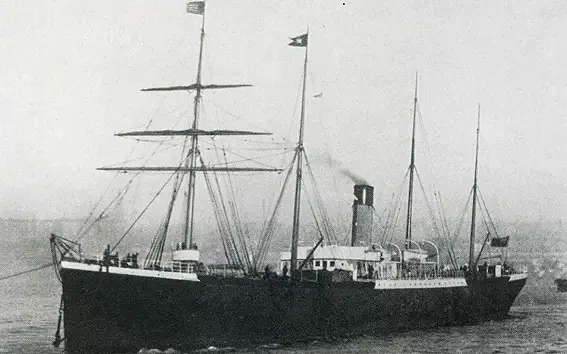
The SS Cufic. (Click image to enlarge)
While aboard the SS Cufic, in February 1898, he received a qualification from the "St John Ambulance Association" which stated he was able to render "First Aid to the Injured" (a stamp indicating this on his later Extra Masters certificate).
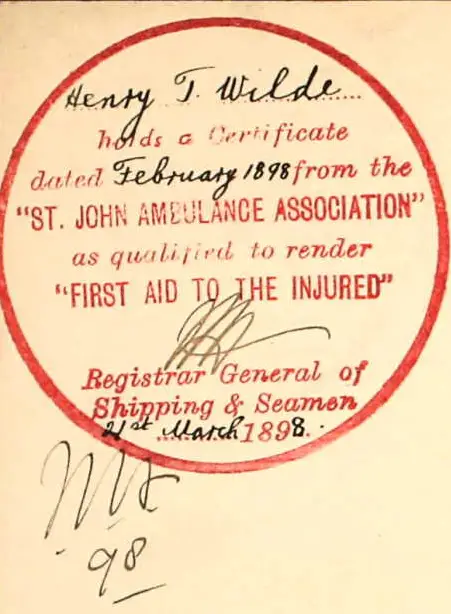
Wilde's qualification from the "St John Ambulance Association" stating "First Aid to the Injured" (via a stamp indicating this on his later Extra Masters certificate).
Promotion and Marriage
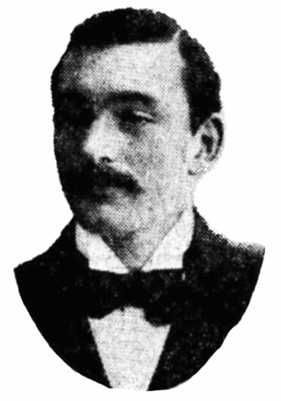
A photograph of Wilde, with a moustache
circa 1890s, courtesy of Elisabeth Chan
(18th April, 1912 edition of Sheffield Evening
Telegraph)
In April 1898 he began work on the SS Tauric, as fourth officer. The SS Tauric was a slightly newer ocean liner built in 1891 by Harland and Wolff for the White Star Line. Though designed as a livestock carrier, Tauric carried a small amount of cabin-(second-) and steerage-(third-) class passengers. It was also a turning point for Wilde who spent 2 months and 10 days aboard her and within that time was promoted to Second Officer.
As well as a promotion to Second Officer (skipping Third Officer) during his time aboard the SS Tauric, there was another life-changing event in Henry Wilde's life. On the 3rd of August, 1898 - Henry married Mary Catherine Jones, who he called "Pollie" (or "Polly"). They were wed in the Welsh Calvanistic Methodist Chapel. They were both 26 years old.
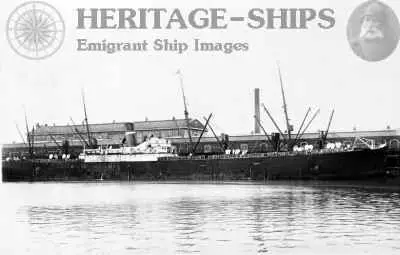
Wilde was promoted from Fourth Officer to Second Officer while aboard the SS Tauric (picture credit: http://www.norwayheritage.com/)
Joining the White Star Line in 1897 meant that his career prospects looked bright enough to consider marriage and a family, and at some point in these years he began his courtship of Mary Catherine ‘Polly’ Jones. Polly’s family were among the many Welsh who had settled in Liverpool, and her father, builder Owen Jones, was reputedly financially well off. Wilde was at that time living at 157 Rice Lane, Walton, and the Jones family in 54 Grey Road, Walton - very near neighbours (Rice Lane runs off Grey Road). ("On Watch" - Nautical-papers.com,2002 by Jemma Hyder and Inger Sheil.)
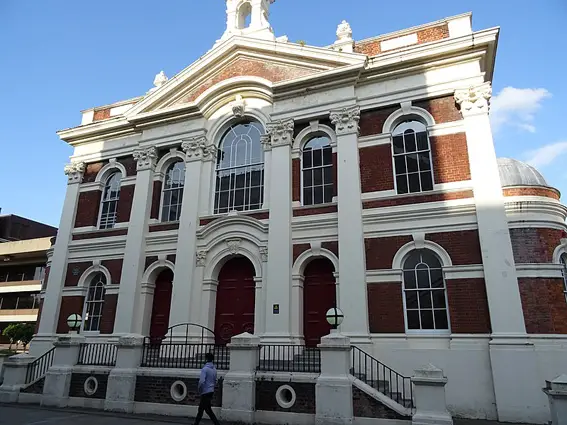
The Welsh Calvinistic Methodist Chapel, Chatham Street, Liverpool, where Henry Wilde and Mary Catherine Jones were married, 3rd of August, 1898.
In September 1898 he was appointed to the SS Delphic, which served the New Zealand trade, once again as second officer and serving aboard her for over a year until October 1899. The SS Delphic was a smaller and slower version of the earlier liner Gothic which also served the New Zealand service, but more space was given over to passenger accommodation rather than cargo, and this gave Delphic a capacity for 1,000 steerage passengers.
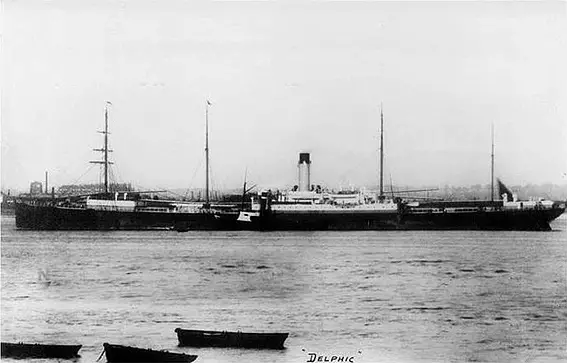
The SS Delphic, which served the New Zealand trade. Wilde worked aboard her as second officer for over a year.
Then in October 1899 he was transferred from the Delphic to the SS Cufic once again, but now as second officer, working aboard her until May 1900.
He remained with her until May 1900, when - perhaps prompted by the fact that securing it would enhance his promotion prospects within the company, increasing his chances of leaving the junior positions on cargo ships behind - he decided to re-sit the examination for his Extra Master’s certificate. An Extra Master’s certificate was considered a desirable attribute by the White Star Line, and their officers were encouraged to obtain it. Of his Titanic colleagues, only three of the Juniors, Herbert Pitman, Harold Lowe and James Moody, did not gain this additional certification. Armed with a reference from the company testifying to the ability and conduct he had shown over the two years and ten months he had served with the Line, Wilde re-sat the examination on the 9 July 1900. This time he passed. ("On Watch" - Nautical-papers.com, 2002 by Jemma Hyder and Inger Sheil.)
Having sat and passed his Extra Masters certificate on the 9th of July 1900, the certificate was issued in Liverpool on the 19th of July 1900, his address listed as 54 Grey Road, Walton, Liverpool.
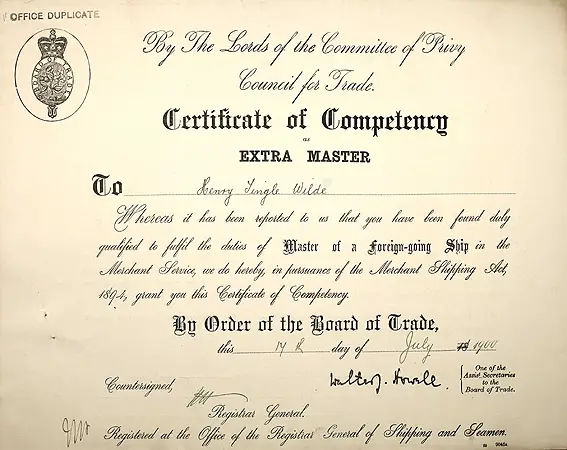
An "Office Duplicate" of Wilde's Extra Masters certificate.
SS Persic and Australia
There is a gap in the paperwork between July 1900 and his next ship - the SS Persic, a Liverpool to Sydney ship aboard which he is listed as the First officer. The SS Persic was one of the five 'Jubilee Class' ships (the others being the Afric, Medic, Suevic and Runic) built specifically to service the Liverpool–Cape Town–Sydney route. The voyage took six weeks.
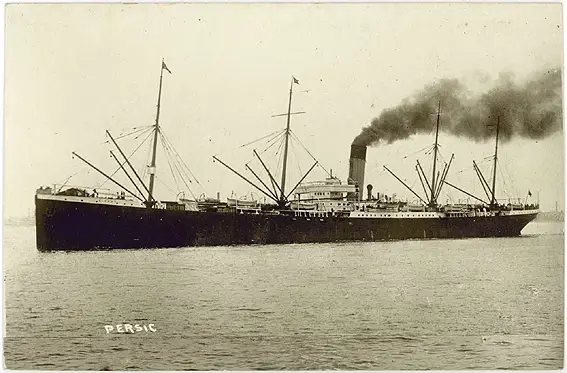
Wilde was First Officer aboard the SS Persic on the Liverpool to Sydney route. (Click image to enlarge)
Wilde is listed as arriving in Sydney on the 7th of December 1901, aged 28. This was no ordinary voyage. According to The Express and Telegraph (Adelaide) dated Friday 29 Nov 1901 her November 1901 journey from Liverpool via Cape Town saw a passenger manifest of 335 passengers being 15 bound for Adelaide, 113 for Melbourne, and 207 for Sydney. On board were invalided and time-expired Australian and New Zealand soldiers from the Boer War. Captain F. H. Armstrong, former chief officer of the SS Medic, was in command.
Its departure from Sydney also made the news. The Daily Telegraph (Sydney) of Friday 20th of Dec 1901: "She carries a very large and varied cargo, comprising amongst other lines 10,200 bales wool, 300 tons cocoanut oil, 160 casks tallow, 1467 Ingots tin, 140 tons chrome ore, 120 bales sheepskins, 30 bales furskins, 16,130 carcases mutton and lamb, and 1200 boxes butter. The Persic still maintains her popularity with travellers, as evidenced by the fact that over 100 passengers will leave by her to-day."
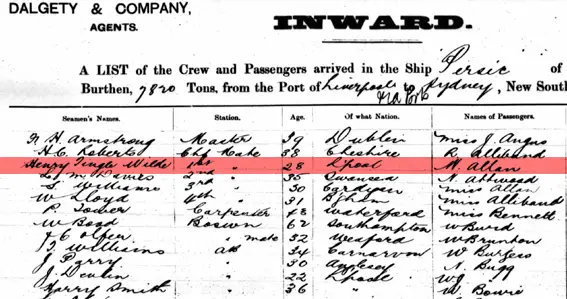
Wilde is listed aboard the SS Persic as First Officer on the Liverpool to Sydney sailing in December 1901. (Click image to enlarge)
Royal Naval Reserves
On the 26th of June 1902 he was officially recognised as the Royal Naval Rerserve rank Sub Lieutenant.
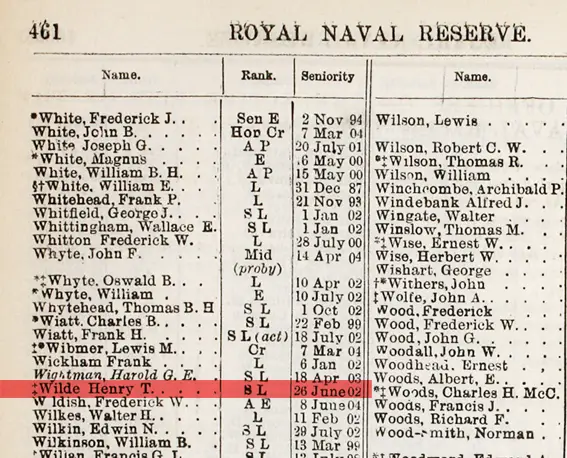
RNR listing Wilde as officially recognised as the Royal Naval Rerserve rank Sub Lieutenant on the 26th of June 1902. (Click image to enlarge)
Like most of his fellow White Star officers, he was also active in the Royal Naval Reserves (RNR), receiving a commission as a sub-lieutenant on the 26 February 1902 and promotion to the rank of Lieutenant on the 12 June 1905. By way of comparison, William Murdoch’s sub-lieutenant’s commission was gazetted on the 1 January 1902, but he was not promoted to full lieutenant until the 8 September 1909. ("On Watch" - Nautical-papers.com, 2002 by Jemma Hyder and Inger Sheil.)
On the 9th May 1902 he was still aboard the Persic, as First Officer on another Australian voyage. But he was not enjoying the long Australian runs, writing to his sister-in-law Annie on the 3rd of November 1902: "I don't want to come out this way anymore. I have been more than twelve months in this ship now, and that is more than usual for me to stay in one ship." (Sincerely Harry, by Michael Beatty (63.))